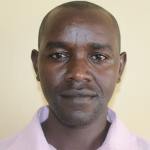The 140 people living in the Luokho Community struggle to access safe, sufficient water daily. Their primary water source, Boniface Mutende Spring, is unprotected, overcrowded, and contaminated, causing more problems than it can solve.

The overcrowded spring.
"I just can't believe what happened to me. My body had [a] high fever, above normal, which made me to sweat intensely and lose a lot of water. For the first time in my life, I was diagnosed with typhoid. Ignorance in practicing simple and cheaper acts like boiling drinking water or maintaining water hygiene can lead to huge bills that burden an individual, family, and community as a whole. My case really taught me lessons. I had [to] pay a significant amount of money to be well, which really [had an] impact on my family budget," shared 60-year-old Ms. Jane Mwonjia.

Ms. Jane Mwonjia.
Jane is a community health worker who visits people's homes, encouraging them to seek healthcare when necessary. However, her recent bout of sickness, caused by drinking the spring's contaminated water, has kept her from doing her job and created hardship for her family.
"Serving as a community health volunteer, my main duty is visiting community members to assess their health situation and recommend them to seek attention from health care facilities. As a result of being sick because of water-related illnesses, I cannot move around, meaning that I will not meet my target and also not earn a living. No work, no pay," said Jane.

Jane collecting water.
"Drinking water that harms is like taking an arrow and piercing the heart; it is really painful," Jane said.
Sadly, being sick from drinking the contaminated water is not the only struggle Jane faces as a result of the spring. It is also overcrowded. People waste time waiting in long lines, and community tensions rise. This causes her and others in the community to make difficult choices: either neglect their daily tasks or ration the water they have time to collect. Either way, it is not ideal.
"Waiting to fetch water sometimes can take around 30 minutes, being the longest period. This is as a result of many people meeting at the water source at the same time to fetch water. Congestion at the water source causes a snarl-up, leading [to] time wasting and conflict," said Jane.
Jane desires to serve her community, but until she has safe, reliable water, she risks her health and family's livelihood each time she consumes water from the spring.

Jane watering her cattle.
"If I did not have to fetch water, I would use that time to tirelessly serve my community. Being a volunteer, there are several demands from the community which require close attention, such as being a caregiver," Jane concluded.
The community's spring needs to be properly protected so people can be assured that the water they work so hard to collect is safe to consume.
"Community members are in need of a better water source that is able to serve them well, having all aspects addressed to control all forms of contamination. With this intervention, they will be assured of [the] safety of their water and will be free from reported cases of water-related diseases which sap their time and resources in dealing with the consequences," Field Officer Wilson Kipchoge.
Steps Toward a Solution
Our technical experts worked with the local community to identify the most effective solution to their water crisis. They decided to safeguard the existing flowing spring.
Spring Protection
Springs are natural water sources that originate from deep underground. As water travels through various layers of the earth, it undergoes a natural filtration process, making it cleaner and safer to drink. To protect these spring sources from contamination, we construct a waterproof cement structure around layers of clay, stone, and soil. This design channels the spring water through a discharge pipe, facilitating easier, faster, and cleaner water collection.
Chlorine Dispenser
As an extra measure towards water quality safety, uniquely engineered chlorine dispensers are installed at all of our spring protection projects so community members can treat their water with pre-measured doses of chlorine. The chlorine treats any residual contamination and stays active for two to three days, ensuring water stays safe to use even when stored at home. Chlorine delivery and maintenance of the dispensers are part of our ongoing community support.
Community Education & Ownership
Hygiene and sanitation training are integral to our water projects. Training is tailored to each community's specific needs and includes key topics such as proper water handling, improved hygiene practices, disease transmission prevention, and care of the new water point. Safe water and improved hygiene habits foster a healthier future for everyone in the community. Encouraged and supported by the guidance of our team, a water user committee representative of the community's diverse members assumes responsibility for maintaining the water point, often gathering fees to ensure its upkeep.

 Protected Spring
Protected Spring
 Rehabilitation Project
Rehabilitation Project


















